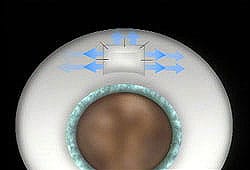It is estimated that well over two million Americans have some type of glaucoma and half of them do not know it. Ninety percent of glaucoma patients have open-angle glaucoma. Although it cannot be cured, it can usually be controlled. Vision loss may be minimized with early treatment. The eye receives its nourishment from a clear fluid that circulates inside the eye.
This fluid must be constantly returned to the blood stream through the eye’s drainage canal, called the trabecular meshwork. In the case of open-angle glaucoma, something has gone wrong with the drainage canal. When the fluid cannot drain fast enough, pressure inside the eye begins to build.
This excess fluid pressure pushes against the delicate optic nerve that connects the eye to the brain. If the pressure remains too high for too long, irreversible vision loss can occur.
Symptoms of open-angle glaucoma:
- In the early stages, there are no symptoms of blurred vision or pain
- Gradual loss of peripheral vision (the top, sides and bottom areas of vision) that is not perceptible to most people until the disease is in the advanced stages
Who is at risk:
Glaucoma can occur in people of all races at any age. However, the likelihood of developing glaucoma increases if you:
- are African American
- have a family history of glaucoma
- are diabetic
- are very nearsighted
- are over 40 years of age
Diagnosing open-angle glaucoma:
Everyone should be checked for glaucoma at around age 35 and especially at age 40 and over. Those considered to be at higher risk, including those over the age of 60 should have their pressure checked every year or two. Ideally, you should have an eye exam every 2 years no matter what age you are.
Your doctor will use tonometry to check your eye pressure. After applying numbing drops, the tonometer is gently pressed against the eye and its resistance is measured and recorded. Sometimes pressure is checked using the air puff test as well.
Eye pressure is not directly related to blood pressure. The “normal” pressure ranges from 10 to 21. However, it is important to know that many people with eye pressure in the normal range have glaucoma, and many with pressure above the normal range do not. There are many other factors that determine glaucoma, including:
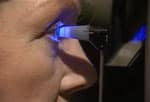
Tonometry is used to check your eye pressure
The Optic Nerve: This is the structure in the eye that suffers damage from eye pressure that is too high for an individual eye to tolerate. An ophthalmoscope can be used to examine the shape and color of your optic nerve. The ophthalmoscope magnifies and lights up the inside of the eye. Cupping or atrophy of the optic nerve will be carefully evaluated. If the optic nerve appears to be cupped or is not a healthy pink color, additional tests will be run.
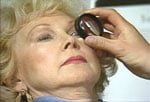
An ophthalmoscope is used to examine your optic nerve
Perimetry, or visual field testing,is a test that maps the field of vision. Looking straight ahead into a white, bowl-shaped area, you’ll indicate when you’re able to detect lights as they are brought into your field of vision. This map allows your doctor to see any pattern of side or peripheral vision changes caused by the early stages of glaucoma. This is a somewhat tedious test for the patient, but with modern instruments can be done in 15 minutes or less. The results are extremely important in diagnosing and managing glaucoma.
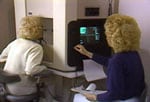
Perimetry maps your field of vision
Gonioscopy is used to check whether the angle where the iris meets the cornea is open or closed. This helps your doctor determine if they are dealing with open-angle glaucoma or narrow-angle glaucoma. Narrow angle glaucoma (please refer to the section on this condition) is a fairly uncommon condition. Most people with glaucoma have the open angle variety. Gonioscopy is the procedure that helps determine which type of glaucoma you have.
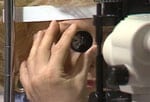
Goniscopy is used to help your glaucoma type
Treatments for open-angle glaucoma:
To control glaucoma, your doctor will start with eyedrops to control the pressure. If your glaucoma is advanced or does not respond to conventional treatment, you may be referred to the Glaucoma Center at Omni Eye Services. The specialists will adjust medicines, or consider laser treatment, or in severe cases, filtration surgery. The goal of treatment is to lower the pressure in the eye.
Glaucoma medicines come in eye drop form and pill form. Pills are rarely used anymore due to side effects, but are still an option. Drops work by either slowing the production of fluid within the eye or by improving the flow through the drainage meshwork. To be effective, most glaucoma medications must be taken once or twice every day, without fail. Some of these medications have some undesirable side effects, so your doctor will work with you to find a medication that controls your pressure with the least amount of side effects. Medicines should never be stopped without consulting your doctor, and you should notify all of your other doctors about the eye medications you are taking.
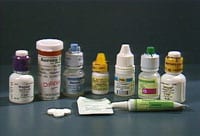
Glaucoma medication comes in many forms
Argon Laser Trabeculoplasty and Selective Laser Trabeculoplasty are in-office laser procedures designed to open the drainage canal. Requiring only numbing eye drops, the laser beam is applied to the trabecular meshwork resulting in an improved rate of drainage. When laser surgery is successful, it may reduce the need for daily medications. Omni Eye Services was the first center of excellence in the Southeast to utilize the new Selective Laser Technology.
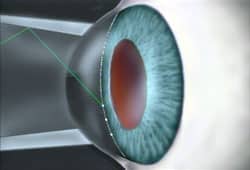
Filtration surgery is performed when medicines and / or laser surgery are unsuccessful in controlling eye pressure. During this microscopic procedure, a new drainage channel is created to allow fluid to drain from the eye.
